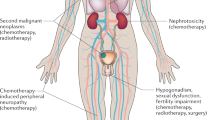Abstract
This study evaluates the degree and relevance of persisting ototoxicity after cisplatin-based standard-dose chemotherapy for testicular cancer, with emphasis on identification of potential factors for an increased risk of this late sequel. Hearing thresholds of 86 patients with a median age of 31 years (range 21-53 years) and a median follow-up time of 58 months (range 15-159 months) were assessed by conventional pure-tone audiometry. Interviews were conducted evaluating the patients' history with special regard to audiological risk factors, as well as circumstances of ototoxic symptoms. Details concerning treatment and patient variables were extracted retrospectively from the patients' charts. An additional screening programme assessed current body functions, blood parameters and other late toxicities. Symptomatic ototoxicity persisted in 20% of patients (59% tinnitus, 18% hearing loss, 23% both), while 10% had experienced completely reversible ototoxic symptoms for a duration of 1-18 months after treatment. Symptoms were bilateral in 81% of patients. Hearing thresholds were compatible with cisplatin-induced hearing loss in 42% of audiograms performed. Subjective (history) and objective (audiogram) findings were not always consistent. The following statistically significant risk factors for ototoxicity were established: high cumulative dose of cisplatin (P < 0.0001); history of noise exposure (P = 0.006). Additionally, high doses of vincristine (P = 0.001) seemed to result in reversible ototoxic symptoms. No other independent risk factors were identified. In conclusion, persisting ototoxicity represents a clinical sequel for approximately 20% of testicular cancer patients treated at standard dose but may affect more than 50% of patients receiving cumulative doses of cisplatin > 400 mg m(-2). Previous noise exposure may also result in a threefold increased risk for cisplatin ototoxicity. Future studies should use these risk factors as important stratification criteria for trials aiming at the evaluation and prevention of cisplatin-induced ototoxicity.
This is a preview of subscription content, access via your institution
Access options
Subscribe to this journal
Receive 24 print issues and online access
$259.00 per year
only $10.79 per issue
Buy this article
- Purchase on Springer Link
- Instant access to full article PDF
Prices may be subject to local taxes which are calculated during checkout
Similar content being viewed by others
Author information
Authors and Affiliations
Rights and permissions
About this article
Cite this article
Bokemeyer, C., Berger, C., Hartmann, J. et al. Analysis of risk factors for cisplatin-induced ototoxicity in patients with testicular cancer. Br J Cancer 77, 1355–1362 (1998). https://doi.org/10.1038/bjc.1998.226
Issue Date:
DOI: https://doi.org/10.1038/bjc.1998.226
This article is cited by
-
Associations among hearing loss, multiple co-occurring symptoms, and quality of life outcomes in cancer survivors
Journal of Cancer Survivorship (2023)
-
Nachsorge bei Hodentumoren
Urologie in der Praxis (2022)
-
Feasibility and first results of a prospective cohort study to investigate cisplatin-associated ototoxicity amongst cancer patients in South Africa
BMC Cancer (2021)
-
Baseline audiological profiling of South African females with cervical cancer: an important attribute for assessing cisplatin-associated ototoxicity
BMC Women's Health (2021)
-
Racial differences in testicular cancer in the United States: descriptive epidemiology
BMC Cancer (2020)



